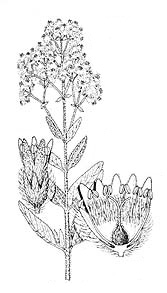Family: Lamiaceae
Dicrastylis doranii
Citation:
F. Muell., Fragm. Phyt. Aust. 8:230 (1874).
Synonymy: D. carnegiei Hemsley, Hook. Ic. ser. 4, 26:pl. 2582 (1899).
Common name: None
Description:
Greyish-tomentose shrub, 40-90 cm high, spreading up to 2 m diam.; stem erect, branched near the base, cinerescent-tomentose; leaves sessile or very shortly petiolate, decussate, narrowly elliptic-lanceolate or elliptic-oblong, cuneate towards the base, flat or almost so, densely but shortly cinerescent-tomentose, 1.5-3.5 cm long, 0.3-0.8 rarely to 1 cm broad, entire, sometimes the margins slightly recurved in the lower half.
Inflorescence terminal; cymes forming head-like small clusters, arranged in a more or less pyramidal panicle; peduncles long and spreading towards the base, greyish-tomentose; cyme heads 3-7- or 9-flowered, 4-8 mm diam., the young apical heads sessile; flowers sessile; bracts elliptic-ovate, 1.3-1.5 rarely to 2.5 mm long, 0.8-1 mm broad, tomentose outside, glabrous inside; calyx 5-lobed in the upper half, rarely 4-lobed, 3-3.5 mm long, densely tomentose outside, glabrous inside; lobes deltoid, short, obtuse, almost equalling the tube, c. 1.5 mm long; tube somewhat cylindrical, 1.5-2 mm long; corolla white, tubular, 5-lobed above, rarely 4-lobed, c. 4 mm long; lobes oblong, obtuse, distinctly crenate at the apex, glandular and tomentose outside, glabrous inside, 1-1.5 mm long, c. l mm broad; tube cylindrical, c. 3 mm long, glabrous outside, villous inside the throat; stamens 5, rarely 4, somewhat included or scarcely exserted; filaments filiform, glabrous, shorter than the corolla lobes; anthers yellowish-brown, lobes oblong, divergent in the lower half; ovary elliptic-obovoid, densely white-tomentose, c. 1 mm diam.; style up to 2.5 mm long (including the lobes), densely tomentose in the lower undivided part, lobes glabrous, c. 1 mm long.
Fruit obovoid, shortly tomentose, 3-3.5 mm long, 2.5-2.7 mm diam., 1- or 2-seeded.

| Flowering branch, flower and opened flower.
|
Image source: fig. 548A in Jessop J.P. & Toelken H.R. (Ed.) 1986. Flora of South Australia (4th edn).
|
Published illustration:
Munir (1978) Brunonia 1:528, fig. 22; Munir in Jessop (1981) Flora of central Australia, fig. 293.
|
|
Distribution:
|
W.Aust.; N.T.
|
Conservation status:
native
Flowering time: mainly Sept. — Dec.
|

SA Distribution Map based
on current data relating to
specimens held in the
State Herbarium of South Australia
|
Biology:
No text
Taxonomic notes:
This species is restricted chiefly to the dry eremean part of W.Aust. The only collection from S.Aust. is from the Officer Basin, south of the Musgrave Range.
Author:
Not yet available
|

